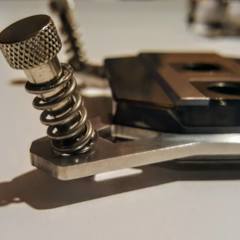-
Posts
17,462 -
Joined
-
Last visited
Content Type
Forums
Status Updates
Blogs
Events
Gallery
Downloads
Store Home
Everything posted by LukeSavenije
-

@Cyberspirit : Thanks for the recommendation br…
LukeSavenije replied to Tech_Dreamer's status update
crucial? where's muh 980 pro? -
Introduction Today I'm going to break down what are in my eyes the most important parts of the Intel ATX Power Supply Specification, but to a more understandable level. I’ll link the full specification below. This document will be based on ATX Design Guide June 2018, revision 002 and will include some outside info. 2.1 Processor Configurations - Recommended This paragraph talks about the second 12v rail, meant only for the CPU. Intel recommends how much current it should allow before shutting down for some of their TDP's. I noted an example of a CPU with the TDP to give an idea, and the amount of watts that would be on this rail. PSU 12V2 Capacity Recommendations Processor TDP Continous Current Peak Current 165w (9980XE) 37.5A (450w) 45.0A (540w) 140w (7900x) 28.0A (336w) 39.0A (468w) 95w (9900k) 22.0A (264w) 29.0A (348w) 65w (9400) 21.0A (252w) 28.0A (336) 35w (9100) 13.0A (156w) 16.5A (198w) you could manually calculate this the following two ways: 12v2 Continuous Current = (SoC sustained Power / VRM efficiency) / 11.4v 12v2 Continuous Current = (SoC Peak Power / VRM efficiency) / 11.4v 3.1: AC Input - Required This part goes into detail regarding what voltages the PSU should be able to handle as input or AC current. If it's rated for 115v, it doesn't mean it can't handle a spike to 130v for example. The two most important ones are listed below in a tableThis part goes into detail regarding what voltages the PSU should be able to handle as input or AC current. If it's rated for 115v, it doesn't mean it can't handle a spike to 130v for example. The two most important ones are listed below in a table. Voltage Minimum Nominal Maximum 115v AC 90v 115v 135v 230v AC 180v 230v 265v 3.1.1: Input Over Current Protection - Required Many will think about Over Current Protection with this, but it's not quite the same, since that's on the other side of the PSU. This follows a similar idea, but on the AC side. It uses fuses to protect the PSU from too high current on the AC side in case of a PSU hardware failure. 3.1.2 Inrush Current - Required Inrush current is the high input current that a PSU or other electrical device pulls for an instant when turning on. Usually, this is caused by charging capacitors It is required to limit it, since you could trip a breaker or even damage the PSU itself without it. 3.1.3: Input Under Voltage - Required Many will again think of the DC side protection, but this is when voltage would drop below the minimum shown in the table above. So if it drops below 90v for 115v or 180v for 230v it will shut itself down to limit damage done to the PSU. 3.2.1: DC Voltage Regulation - Required Now we're going to the other side, the output or DC side. These have to stay inside a margin of 5-10% depending on the rail. You can see this below in a table. Output Range Minimum Nominal Maximum +12V 5% +11.40V +12.00V +12.60V +5V 5% +4.75V +5.00V +5.25V +3.3V 5% +3.14V +3.30V +3.47V +5VSB 5% +4.75V +5.00V +5.25V -12V 10% -10.80V -12.00V -13.20V 3.2.5: Output Ripple Noise - Required Ripple is the AC noise that's still left after conversion to DC voltage. This you should try to keep as low as possible, but Intel set some limits to this in their specification. In the first table you can see Intel's limits, in the second what I personally consider for a PSU within normal operation range, but it's a lot harder to meet. Intel: Output Maximum Ripple +12V 120mV +5V 50mV +3.3V 50mV -12V 120mV +5VSB 50mV Personal: Output Maximum Ripple +12V 50mV +5V 30mV +3.3V 30mV -12V 50mV +5VSB 30mV 3.2.8: +5v DC / +3.3v DC Power Sequencing - Required DC Power Sequencing is the time it has to take between certain rails to start up. This is best explained by looking at the image Intel provides for this. As you can see here, the 3.3v line should always be lower than the others, because of the way a system would boot up. If this fails by a bigger margin, the system won't power on. The impact of a smaller fail is unknown to me. 3.2.9: Voltage Hold-Up Time - Required Voltage hold-up time is simply said that a PSU should be able to at least supply it's maximum rated continuous load for 17ms if the AC input suddenly shuts off. Intel requires this to be at a minimum load of 0A. This does not mean that this will prevent it from cutting power on a longer run. A longer hold-up time (let's say for example 23ms) won't improve this for users except if they own a UPS, as this is the time a good UPS would be able to continue operation. 3.3.1: PWR_OK - Required PWR_OK or Power Good is a signal the PSU sends that the 12V, 5V and 3.3V rails are within limits and that there's enough energy left in the converter to supply it with the specified load. If this signal indicates differently, the PSU or motherboard will shut itself down. 3.3.4: +5VSB - Required 5 Volt StandBy (5VSB) is a rail that supplies power to components when the system isn't powered up. This would for example be to keep motherboard LEDs on, allow for Wake on LAN to work or power USB devices. 3.5.1: Over Voltage Protection (OVP) - Required Over Voltage Protection or OVP is a protection against a too high voltage on a rail. This is technically required for everything but the 5VSB, but is highly recommended to be present there as well. It's generally integrated into the protection IC. In the table below you can see the voltages Intel recommends to set it to. Output Minimum Nominal Maximum +12V 13.40V 15.00V 15.60V +5V 5.74V 6.30V 7.00V +3.3V 3.76V 4.20V 4.30V +5VSB 5.74V 6.30V 7.00V 3.5.2: Short Circuit Protection (SCP) - Required Short Circuit Protection or SCP measures the resistance on each rail, and will shut down when resistance is lower than 0.1 Ohms. Generally this goes combined with OPP, OCP, OVP and UVP. It's generally integrated into the protection IC, and is required on ATX spec, with separate circuits per rail. 3.5.4: Over Current Protection (OCP) - Required The term Over Current Protection or OCP has two types of protection included into the name, being OCP and OPP. Over Power Protection or OPP is a protection that will shut down the PSU when too much power on all rails combined is drawn, generally this is between 110 and 140% of the advertised wattage. This is a protection that works as a limit, shutting down when a certain point is reached, but doesn't actively monitor the amount of current. It's generally integrated into the PWM controller. Over Current Protection or OCP has the same purpose, but a different concept than OPP. OCP will generally be faster than OPP, since it uses shunt resistors to check the amount of current on each individual rail, and will shut down if a certain point is reached. OCP on 12V is generally only found on PSUs with multiple rails, since OPP can handle a single rail just fine. It's generally integrated into the protection IC combined with shunt resistors. To explain the difference very simply is that OPP is a limit for the whole rail and OCP is a more continuous check of every single rail. 3.5.5 Over Temperature Protection (OTP) - Required Over Temperature Protection or OTP protects the PSU against overheating,for example due to a fan failure. it's generally a thermistor combined with a protection IC that supports this, but there have also been cases where it was integrated into the fan controller. Most reviewers stop measuring after 200°C, but it depends on the place the thermistor is integrated what recommended limits are. 3.5.7: Separate Current Limit for 12V2 - Recommended This is basically a different wording for multirail. Multi rail these days aren’t physical rails, rather they have multiple points where they measure the current (generally 2-8). It can shut down the PSU earlier to protect itself, with a lower chance of burning through connectors and/or cables with a catastrophic failure. 3.5.9: Power Supply Efficiency for Energy Regulations, Energy Star and CEC PC Computers with High Expandability Score - Recommended This part of the documentation includes 3 examples of efficiency requirements, being the ones from Energy Star, CEC and Efficiency for Energy Regulations. I'll include the ones from Cybenetics and 80+ as a comparison. Efficiency for Energy Loading Full load (100%) Typical load (50%) Light load (20%) Required minimum 70% 72% 65% Energy Star (version 6.1/7.0) Loading Full load (100%) Typical load (50%) Light load (20%) Minimum (V6.1) 82% 85% 82% Minimum (V7.0) 87% 90% 87% CEC Loading Full load (100%) Typical load (50%) Light load (20%) Minimum (115v) 87% 90% 87% Minimum (230v) 88% 92% 88% Cybenetics Efficiency levels (115V) Efficiency 5VSB Efficiency A++ =>94% - <97% >79% A+ =>91% - <94% >77% A =>88% - <91% >75% A- =>85% - <88% >73% Standard =>82% - <85% >71% Efficiency levels (230v) Efficiency 5VSB Efficiency A++ =>96% >78% A+ =>93% - <96% >76% A =>90% - <93% >74% A- =>87% - <90% >72% Standard =>84% - <87% >70% 80 plus Rating 10% (very low load) 20% (low load) 50% (typical load) 100% (Full load) 80+ 115v 80% 80% 80% 80+ 230v 82% 85% 82% 80+ Bronze 115v 82% 85% 82% 80+ Bronze 230v 85% 88% 85% 80+ Silver 115v 85% 88% 85% 80+ Silver 230v 87% 90% 87% 80+ Gold 115v 85% 89% 85% 80+ Gold 230v 90% 92% 89% 80+ Platinum 115v 90% 94% 89% 80+ Platinum 230v 92% 94% 90% 80+ Titanium 115v 90% 92% 94% 90% 80+ Titanium 230v 90% 94% 96% 94% 4.2.1: AC Connector - Required In this part Intel mentions a IEC 320 or equivalent plug, which might sound complicated, but this is just the name of the well known 3-pin plug you find on most PSUs With that it needs to have a dedicated on/off switch next to it. 4.2.2.1: Main Power Connector - Required orange=3.3v blue=-12v black=ground/communication green=power on red=5v gray=power good purple=5vsb yellow=12v the main power connector, generally called 24 pin connector because of it's 20+4 pins supplies its power via the motherboard to many components, including part of the GPU, memory, the motherboard itself and so on. 4.2.2.2: Peripheral Connectors - Required yellow=12v black=ground/communicaton red=5v Peripheral connectors, or better known as the Molex standard is a connector that's getting more and more rare in favor of other connectors these days. It's used on old GPUs, expansion cards and so on. Fun thing is that Molex was the base for many connectors, including PCI-E, EPS and ATX Main Power. They’re part of the so-called Micro Fit series. 4.2.2.4: PCI-Express (PCI-E) Graphics Card Connector - Required yellow=12v black=communication/ground The PCI-E Graphics Card Connector, or generally called PCI-E connector supplies power to the GPU. A 6 pin is rated for up to 75W, while the 8 pin goes up to 150W. 4.2.2.5: +12V Power Connector - Required yellow=12v black=communication/ground The +12V power connector or 8 (4+4) pin connector is a cable that provides current to the VRM, which then supplies it to the CPU. It follows the EPS standard. 4.2.2.6: Serial ATA (SATA) Connectors - Required orange=3.3v black=communication/ground red=5v yellow=12v Serial ATA or SATA power is mostly used for drives using the SATA standard, but can be used for other things as well. 6.0: Environmental - Recommended A PSU has to be able to: Operate at +10 to +50 degrees Celsius at full load. Survive -40 to +70 degrees Celsius while not operating Operate at a humidity up to 85% Survive a humidity up to 95% while not operating Operate at up to 3.048 meters high Survive non-operational at up to 15.240 meters high Survive a mechanical shock of 50 grams while not operating 8.4: Safety - Required Should a component failure occur, the power supply should not exhibit any of the following: Flame Excessive smoke Burnt PCB Fused PCB conductor Unusual noise Emission of molten material Fail to ground 9.1: Reliablity - Recommended This is relatively simple. Make a unit that's expected to work at least for it's rated lifetime (generally by warranty) by selecting the right components. This would mainly include capacitor and fan lifetime and reliability. 10.0-15.0: CFX12V/LFX12V/ATX12/SFX12V/TFX12V/FLEX ATX Specific Guidelines - Required The last paragraph goes into the many shapes you find power supplies in. here a quick breakdown CFX12V: CFX is a formfactor only really used in SFF sized prebuilts. It's simply said an ATX sized PSU with a cut in it. ATX12V: Standardized formfactor PSU, which is the most common to find. SFX12V: A formfactor for small sized PSUs for use with SFF builds. SFX-L12V: A slightly bigger version of SFX, which allows a 120mm fan to fit up top TFX12V: A formfactor closer to server PSUs in its shape. These are rare to find, mostly in office/HTPCs, but even there SFX is getting more common. FLEX ATX: A formfactor mostly used in small cases, but just like TFX hard to find as SFX becomes more common From Left to right: SFX -> SFX-L -> ATX Sources: https://www.intel.com/content/dam/www/public/us/en/documents/guides/power-supply-design-guide-june.pdf https://en.wikipedia.org/wiki/80_Plus https://linustechtips.com/main/topic/1154199-psu-protections-what-do-they-help-against-and-how-do-they-work/ https://www.cybenetics.com/index.php?option=eta_9-51-40 Credit: @sowon Moritz Plattner - Tech-review.de License
- 4 replies
-
- lukesavenije
- psu
-
(and 4 more)
Tagged with:
-
and silicon motion, phison, toshiba/sandisk/flash forward are small Chinese companies?
-
yes atx motherboard and the atx psu standard have little to do with each other in that way. as long as your case can fit it, no problem
-
it would be
-
Physics say you can't fit as much surface area in a case like that, as @TVwazherewas clearly indicating. Would a 160mm air cooler outperform it? yes would that fit? no
-

Ryzen 3 1200 overclocking, need help
LukeSavenije replied to Lavrans888's topic in CPUs, Motherboards, and Memory
not prefered, but fine -

Ryzen 3 1200 overclocking, need help
LukeSavenije replied to Lavrans888's topic in CPUs, Motherboards, and Memory
there's only one limited review but i'm seeing this already... indicating it's at least a group reg with that, they do claim it meeting c6/c7 sleep states, it looks to have decent enough performance for a groupreg... so going by this... tier c-ish to give an idea? -
most terribly overestimate
-
if a psu cuts power it's actually a psu problem otherwise generally driver issues
-
550, honestly
-
this is the new (2019) focus GX, not the old one except that i'm highly questioning why you got about 3-4 times the wattage you're using in capacity here...
-
@wkdpaul BRB, going to look how to limit your site traffic by disabling the link to the PSU tier list
-
laughs in decent hardware prices and actually decent healthcare because The Netherlands
-
first... get well soon Paul second, i now identify myself as the shoe
-

hm... out of curiosity, what's something you'd…
LukeSavenije replied to LukeSavenije's status update
@Gegger might be something for down the line... it's a rather short, but fun story -

hm... out of curiosity, what's something you'd…
LukeSavenije replied to LukeSavenije's status update
@GrockleTD eh... not quite my thing, honestly -

hm... out of curiosity, what's something you'd…
LukeSavenije replied to LukeSavenije's status update
@will4623 rosewill is impossible to get in Europe, and i don't have proper tools to test it yet @Den-Fi 12vo? that's... quite a good one actually -

hm... out of curiosity, what's something you'd…
LukeSavenije replied to LukeSavenije's status update
i said realistic Den -
-
-

You can use those psus in a normal rig, either by soldering lines directly to the fingers or getting a breakout board (a lot of those were made for miners)
-

-

@Gegger might be something for down the line... it's a rather short, but fun story
-
one: you just revived a thread from almost a year ago two: that's raider, not raider ii, which is even worse since it's group regulated, which would become clearly visible why it's not a good thing if you crossload it
-
there is also the thermaltake core p series, which can be used in a testbench-like mode. here is for example a filled up core p5 GN did a review here of the p3: I know Lian Li has a couple ones as well, but i'm not sure about the quality of them
-
as you're literally limiting it to 1/8th of the bandwidth, yes















.png)


